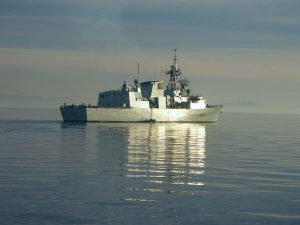In 2016, Conservative Canadian Senator Thanh Hai Ngo introduced a motion for Canada to take a more “principled position” on China’s adventurism in the South China Sea. Adopted in April 2018, Ngo’s motion was non-binding and passed by a chamber out of favor with Canadians – but its central proposition is actualizing in policy. First, the Trudeau government has sharply changed its willingness to direct condemnations at China specifically, a departure from when it employed rhetoric that uniformly told all parties to adhere to international law. Second, the Royal Canadian Navy’s (RCN) transits within the waters and traverses near the hotly contested islands demonstrate a Canada that is more resolved to standing up to China.
The RCN has on various occasions transited the Taiwan Strait and the South China Sea (while shadowed by Chinese vessels), raising the ire of Beijing. One very recent example came on March 29-30, when the frigate HMCS Calgary passed by the Spratly Islands during a trip from Brunei to Vietnam. Even if Canada does not engage in U.S. freedom of navigation operations (FONOPs), its naval presence in the South China Sea is unmistakably higher compared to years past. Those that know Canadian foreign policy well also know the importance of maintaining a healthy separation from U.S. policy – so it shouldn’t be too surprising that Canada is choosing its own path in demonstrating assertiveness against China’s adventurism.
A government document describes a 2020 sailing by HMCS Ottawa in the South China Sea as having “demonstrated Canadian support for our closest partners and allies, regional security and the rules-based international order”. Naval passages in the South China Sea are approved by the most prestigious levels of Global Affairs Canada and the Department of National Defense before they are enacted.
Canada has also upped its partnerships with countries and regional intuitions that govern the South China Sea. In early November of last year, Minister of Defense Harjit Sajjan presented to the 12th South China Sea International Conference in Hanoi, where he said: “Canada opposes unilateral actions that have escalated tensions in the region and undermined stability in the South China Sea We are against the threat or use of force, large-scale land reclamation, building outposts on disputed entities and using them for military purposes in the sea.” In December 2020, Sajjan participated in the ASEAN Defense Ministers’ Meeting Plus. Canada has resident defense attaché positions in Malaysia and Vietnam. Canada signed an MoU on defense cooperation with Vietnam in May 2019, and Canadian naval ships visited Vietnam’s Cam Ranh International Port for the first time in June 2019.
In the past, Canada’s Prime Minister Justin Trudeau has been criticized for avoiding South China Sea issues altogether, such as in 2016 when Trudeau met with Japan’s Prime Minister Abe Shinzo and publicly stressed joint humanitarian initiatives with Japan but “sidestepped” the South China Sea when speaking to the press. Trudeau was also careful to not identify a culprit in the disputes when speaking to the press at the 2015 APEC Leaders’ Meeting in the Philippines.
The tone has changed for Ottawa. Sajjan told the House of Common’s special committee on China in April of this year that “Canada opposes land reclamation projects and building outposts in disputed areas for military purposes.” Canadian Ambassador to the Philippines Peter MacArthur stated in a March 24 tweet that Canada “opposes recent Chinese actions in the South China Sea, including off the coast of the Philippines.”
Today, a big question remains whether Canada should participate in U.S.-led FONOPs in the South China Sea. Canada’s conspicuous silence on U.S.-led FONOPs is chained to the concern that Ottawa will set a precedent for the Canada-U.S. dispute over the Northwest Passage, a bourgeoning waterway through the Canadian Arctic Archipelago that the U.S. maintains is an international conduit.
On the other hand, it can be argued that Canada’s Arctic sovereignty interest is a pull factor to the South China Sea. Worryingly, as Ngo highlighted in his position paper: “in 2016, the China Maritime Safety Organization published a detailed shipping guidebook to the Northwest Passage.” In September of 2017, Xinhua News Agency wrote that the icebreaker Xuelong “accumulated a wealth of experience for Chinese ships going through the Northwest Passage in the future.” If China is already willing to sail through a narrow, weaving waterway in what Ottawa claims as Canadian internal waters, why should Canada hesitate to sail through an open sea that hosts trillions of dollars’ worth of international trade?
The downward spiral in Sino-Canadian relations in other domains has also been a forceful factor pushing Canada to become more involved in the South China Sea. The ongoing Meng Wanzhou dispute and the retaliatory detention of two Canadians is catalyzing a more assertive Trudeau government policy on China. On top of that, like many other Western countries, Canada has clashed with China on its “core interests”; Ottawa opposed the Hong Kong national security law at the United Nations, supported a U.S.-led movement for Taiwanese observer status in the World Health Organization, and continues to firmly condemn China’s abuses of Uyghurs in Xinjiang. A summer 2020 Global Attitudes survey had 36 percent of Canadians with a “somewhat unfavorable” view of China, and 37 percent with a “very unfavorable” view.
Under these conditions, look for Canada to continue entering the fray in the South China Sea.

































